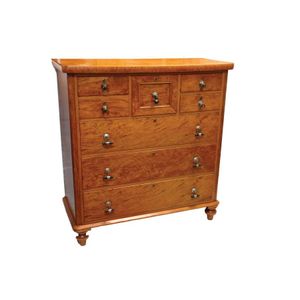Georgian Oak Chest on Chest with Brass Handles
You must be a subscriber, and be logged in to view price and dealer details.
Subscribe Now to view actual auction price for this item
When you subscribe, you have the option of setting the currency in which to display prices to $Au, $US, $NZ or Stg.
- Escutcheons - An escutcheon is a plate, made of brass, wood, ivory or ebony, which fits into or over the h keyhole, to protect the edge of the timber keyhole from damage by continual insertions of the key. As a general rule you would expect these escutcheons to be sympathetic in design to the handles of the piece. From the early 19th century escutcheons were sometimes made from ivory, ebony, bone or contrasting wood, often cut in a diamond or shield shape and inlaid into the front. Ivory, in particular, will tend to discolour with age, and certainly should not show up as brilliantly white.
- Georgian - As an English stylistic period, Georgian is usually taken to cover the period from George I (1714) to the Regency of Prince George (1811-20), although the period from 1800 to 1830 is sometimes designated as the Regency period. During the Georgian period the great English cabinetmakers and designers such as Chippendale, Hepplewhite, Adam Sheraton etc., were all active.
Therefore there isn't a single 'Georgian style' as such and to say something is 'Georgian', usually means it was made between 1714 and 1830. This assumes we discount George V and George VI, both being from the 20th century.
The styles popular at the time of each reign were:
George I (1714-1727) saw out the last years of the Baroque period.
George II (1727-1760) reigned during the Rococo period.
George III (1760-1820) saw the last gasp of the Rococo, all of the early Neo-Classic 'Adam style' and most of the later neo-Classic 'Regency style'.
George IV (Prince Regent 1820-1830)encompassed the last of the 'Regency' style.
William IV's reign (1830-1837) was something of a no man's land (stylistically) and he wasn't a 'George' anyway. He covered the last glimmerings of 'Regency' and the start of the 'Victorian' style. - Bracket Feet - On bracket feet the corner edge is square and joined by a mitre to its partner on the opposite angle. The inner edge is usually shaped or scalloped. Bracket feet were first introduced in the early 18th century and used until c. 1830 and are found on carcase furniture such as chests, cabinets, bookcases and bureaux.
Ogee bracket feet, a variation on straight bracket feet, have the outside edge forming an "S" shaped curve with the top bulging outward and the bottom turning inward.
On splayed bracket feet, the exterior edge curves outward. - Oak - Native to Europe and England, oak has been used for joinery, furniture and building since the beginning of the medieval civilisation. It is a pale yellow in colour when freshly cut and darkens with age to a mid brown colour.
Oak as a furniture timber was superceded by walnut in the 17th century, and in the 18th century by mahogany,
Semi-fossilised bog oak is black in colour, and is found in peat bogs where the trees have fallen and been preserved from decay by the bog. It is used for jewellery and small carved trinkets.
Pollard oak is taken from an oak that has been regularly pollarded, that is the upper branches have been removed at the top of the trunk, result that new branches would appear, and over time the top would become ball-like. . When harvested and sawn, the timber displays a continuous surface of knotty circles. The timber was scarce and expensive and was used in more expensive pieces of furniture in the Regency and Victorian periods. - Drop Handles - In furniture of the late 17th and early 18th centuries, small metal drop handles were often used, frequently in a pear or tear shape. The back plate, to which the drop was attached, may be either a simple plain circle, or in the form of a star or diamond. These handles have been widely reproduced, and are frequently found on Jacobean and Queen Anne style furniture made after the first world war. Reproduction handles can usually be identified by the inferior quality of the metal used during the 1920s and 1930s, sometimes thinly coated with brass or copper, though modern copies are often of excellent quality.
- Pediment - The uppermost section of a tall usually double-heightened piece of cabinet furniture, surmounting the cornice. The pediment can take a variety of forms derived from the architecture of classical antiquity. A broken pediment is of triangular shape, however, the two raised sides do not meet at the apex but are 'broken' the gap between them often ornamented with an urn or finial. Swan-neck pediments are of similar form, although the uprights are gracefully arched, resembling a swan's neck. They are often found, for example, on longcase clocks.
This item has been included into following indexes:
Visually similar items

A good quality William Norrie New Zealand colonial kauri scotch chest, with mottled facings, the central top hat drawer with a pair of small drawers on either side and three deep full width drawers below, rounded side edges, deep plinth top, short turned l

George III mahogany chest on chest with moulded dentil cornice, two short and three long graduated drawers, the base with brushing slide, three drawers below on bracket feet

A good quality N.Z. colonial kauri Scotch chest, with mottled facings, the central top hat drawer with a pair of small drawers on either side and three deep full width drawers below, rounded side edges, deep plinth top, short turned legs and original wood

Georgian mahogany chest on chest c. 1780 moulded cornice above two short and six long graduated drawers, with brass handles and escutcheons. Height 199 cm
